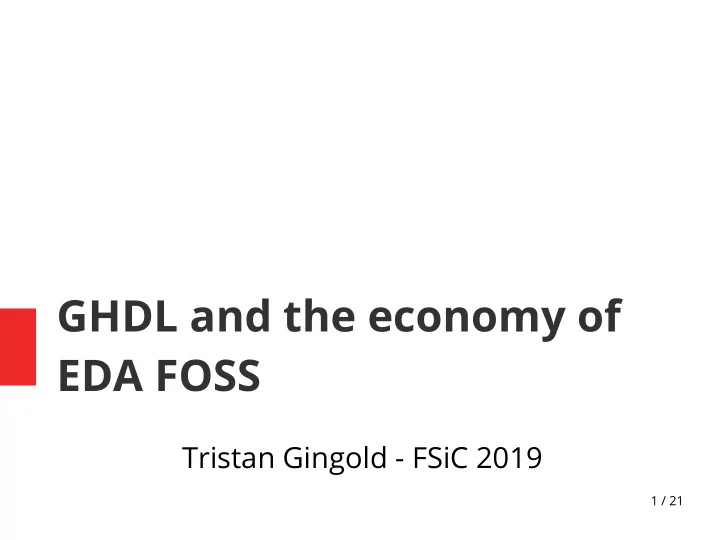

GHDL and the economy of EDA FOSS Tristan Gingold - FSiC 2019 1 / 21
What is GHDL ? ● A Free (GPL v2+) VHDL simulator ● Supports IEEE 1076 (VHDL) 1987, 1993 and 2008 (partially) ● Compiled ● Command line tool ● Binaries for Linux (x86, x64), Windows, MacOS ● Generates VCD, GHW and FST waveforms ● VPI support (for external tools like cocotb) 2 / 21
What does it support ? ● Full support of VHDL-87 and 93 – Your design should work ● Partial support of VHDL-2008 – Good enough for VUnit, OSVVM and UVVM. ● Support inline PSL (assert and cover) – Creates an NFA 3 / 21
Internal view ● Generate tokens scan.adb Scanner parse.adb ● Generate the AST Parser AST Library Semantic ● Create links in the AST sem*.adb manager analysis ● Semantic checks ● Rewrite as processes canon.adb Transformation Code ● Generate a low-level AST trans*.adb generation mcode ● Generate object code llvm, gcc, mcode 4 / 21
Elaboration ● Object code can be generated: – File per fjle (gcc or llvm backend) ● No C generated, it is ghdl1 – For the whole design (mcode – an internal JIT) ● Very fast and lightweight, no opt ● Elaboration is dynamic – Done early during execution – Prevents many optimizations 5 / 21
Abstract Syntax Tree - AST ● Represent the sources ● Closely follow the VHDL L anguage R eference M anual – Simplify the support of the language – Possible as the LRM is well/correctly written ● Strongly typed – Each fjeld of a node has a type 6 / 21
Abstract Syntax Tree - AST ● Nodes are represented by 32-bit numbers – Shorter than pointers on 64 bit platforms ● Nodes size is fjxed (32 or 64 bytes) – Possible to implement parallel tables – To extend the nodes (eg: in translate) 7 / 21
Abstract Syntax Tree - AST ● Meta-description – Type: node, list, number, fmags, … – Links: own, reference, maybe-own – Simplify package instantiation or dump. ● Described using ad-hoc comments 8 / 21
Why Ada ? ● GHDL is written in Ada ● A subset (imperative, sequential) ● Strong typing ● Modular language ● Stable ● VHDL is very similar to Ada – If you know one, you will be familiar with the other ● Makes contribution less easy ? 9 / 21
The future of GHDL More vhdl-2008 features More PSL GUI – easier to use More VPI Speed/performances Verilog/SV support Checkpoints Coverage SystemC AMS Language server protocol *Spice interface Synthesis (netlist generation) 10 / 21
Collaboration: analog ● VHDL-AMS: – Parsing and analysing AMS extensions – DAE solver ● Spice/GnuCap – Linking simulation kernel together 11 / 21
Collaboration: Synthesis ● Proof of concept (ghdlsynth) – Need to support arrays – Yosys module 12 / 21
Collaboration: SystemVerilog ● Mixed vhdl + verilog/systemverilog – Even support SystemC ? ● SystemVerilog – Start from scratch ? – Or start from an existing simulator ? 13 / 21
Priority ? More vhdl-2008 features More PSL GUI – easier to use More VPI Speed/performances Verilog/SV support Checkpoints Coverage SystemC AMS Language server protocol *Spice interface Synthesis (netlist generation) 14 / 21
The economy of EDA FOSS ● My experience ● My feelings 15 / 21
Why writing FOSS EDA tool ? ● By philosophy – I want FOSS everywhere ● Academic research project – I need a tool for my research project or my PhD ● To understand a technology – I’d like to learn a language ● To improve my tooling – The tool is crappy – I need a specifjc feature 16 / 21
Audience / market ● Maybe 100x CS engineers than EE engineers – Do not expect a lot of users! ● Cost: you just need a computer to write an app, you need >40$ for a little EE project ● Culture: FOSS is SW fjrst – Many HW designers are happy with closed source EDA 17 / 21
Contributions ● Skill: EE is not CS – HW people aren’t SW developers – SW people aren’t interested in HW design ● Tools are already available – Free HDL simulators, synthesis, P&R – Why working on a FOSS project ? ● Do not expect many contributions – YMMV ? 18 / 21
Complexity ● Lot’s of complex algorithms or data structure – BDD, SAT, NP-hard, simulated annealing… ● Makes EDA very interesting / challenging ● But not for beginners ● Need more time to tune an algorithm ● Reuse existing libraries – When possible – When existing 19 / 21
Closed ecosystem ● Most low-level information are not available – FPGA bitstream and characteristics – Foundry processes – IP cores are encrypted – File formats (schematic, waveforms…) ● Diffjcult to write a FOSS element 20 / 21
Maturity ● Prototype vs mature software ● Users need reliable and stable software ● Authors usually need a prototype ● Technology changes quickly ● Need to use industry fjle formats ● My experience: – every VHDL feature has been used – diffjcult to support only a subset 21 / 21
Recommend
More recommend